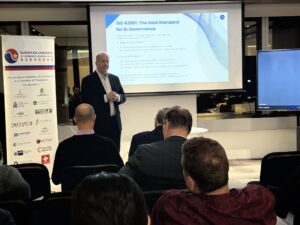Artificial Intelligence is no longer experimental. It’s embedded into core enterprise processes, decision-making systems, and customer-facing applications. Yet, while AI has evolved at breakneck speed, governance models haven’t kept up.
The old compliance playbook — built for traditional software and static systems — is dangerously inadequate for today’s dynamic, complex AI ecosystems. Enterprises that continue relying on outdated frameworks are exposing themselves to operational, reputational, and regulatory risks.
It’s time for a new approach: dynamic, end-to-end AI governance that evolves with the technology itself. Enterprises that invest now will not only protect themselves — they’ll lead in trust, resilience, and innovation.
Why Traditional AI Governance Fails in the Modern Enterprise
Most early AI governance efforts borrowed from conventional IT compliance: privacy checklists, periodic audits, and siloed risk assessments.
That approach no longer works.
Modern AI systems are non-static, especially those using machine learning or generative models. They adapt, self-learn, drift over time, and operate in unpredictable environments. A model that passed a risk assessment last quarter could become non-compliant today without warning.
Key reasons the old playbook fails:
- Static compliance processes can’t monitor evolving AI behaviors.
- Periodic audits miss risks that emerge between checkpoints.
- Black-box models undermine transparency and explainability requirements.
- Ethical considerations are treated as afterthoughts, not integrated into development.
Simply put, governance must now be continuous, holistic, and proactive, not reactive.
New Principles for Modern AI Governance
Forward-looking enterprises are embracing a new set of governance principles built for the realities of modern AI:
1. Continuous, Not Periodic, Governance
Governance isn’t a one-time certification. It’s an always-on process. Enterprises must monitor models in production for performance, fairness, bias, and compliance — in real time.
2. Model Transparency at Every Stage
Explainability isn’t optional. Enterprises must demand documentation, transparency, and interpretability from initial model design through deployment and updates.
3. Integrated Risk Controls at Data and Model Levels
Risk mitigation starts before a single model is trained. Data quality, labeling biases, and training practices must be governed with the same rigor as the final model outputs.
4. Global Compliance Awareness
AI regulations are proliferating worldwide — from the EU AI Act to the U.S. Algorithmic Accountability Act. Governance frameworks must flexibly map and manage compliance obligations across jurisdictions.
5. Human-Centric Ethical Oversight
AI decisions impact real people. Governance must include ethical reviews embedded into development pipelines, not bolted on after deployment.
Building a Future-Ready AI Governance Framework: Step-by-Step Guide
So how can enterprises move beyond outdated models and build a governance framework that’s fit for the future? Here’s the blueprint:
Step 1: Audit Your AI Footprint
Many enterprises are unaware of the full extent of their AI usage, especially “shadow AI” projects built without formal oversight. Conduct a comprehensive audit to catalog all AI systems, models, datasets, and APIs in use.
Step 2: Define Your AI Risk Appetite
Not all risks are equal. Enterprises must define acceptable levels of risk for different AI use cases, aligned to business strategy and stakeholder expectations. High-risk applications (e.g., healthcare diagnostics, financial approvals) require stricter governance than lower-risk AI (e.g., internal process optimization).
Step 3: Create Dynamic Risk Monitoring Pipelines
Move beyond static compliance checklists. Build real-time pipelines that monitor:
- Model performance
- Bias detection
- Data drift
- Regulatory compliance triggers
Automation is critical here; manual reviews cannot scale to enterprise-level AI ecosystems.
Step 4: Implement Explainability Standards
Every AI system must be auditable and explainable — to regulators, internal reviewers, and customers if necessary. Mandate model cards, documentation, decision trees, and other interpretability practices at every lifecycle stage.
Step 5: Embed Ethics Reviews into Development
Shift left: integrate ethical impact assessments into model development processes, not post-launch cleanups.
Questions to embed:
- Could this model reinforce bias?
- Could outputs cause harm?
- Is there meaningful human oversight?
Step 6: Invest in AI Governance Technology
Manual tracking and ad-hoc spreadsheets won’t work. Enterprises need dedicated platforms that automate monitoring, map regulatory obligations, generate audit trails, and surface risks dynamically.
Step 7: Build a Culture of AI Responsibility
Governance isn’t just about policies — it’s about people. Train developers, data scientists, executives, and product teams to understand AI risks, ethics, and regulatory obligations. Create a culture where responsible AI development is a core value, not an afterthought.
Emerging Challenges Enterprises Must Prepare For
Even with strong governance foundations, enterprises must stay ahead of emerging risks:
1. Regulatory Complexity Explosion
The EU AI Act sets the tone for global AI regulation, but every major economy is creating its own rules. Enterprises must manage a growing patchwork of overlapping and sometimes conflicting regulations.
2. Third-Party AI Risks
Most enterprises use external AI APIs or embedded models (e.g., ChatGPT integrations). Governance must extend to these third-party systems, with clear vendor risk assessments and accountability frameworks.
3. Rise of Autonomous AI Agents
AI agents that self-actuate (e.g., booking travel, responding to customers, managing supply chains) introduce new governance challenges. How do you govern decision-making autonomy at scale?
4. Bias Amplification Risks
Bias doesn’t end after deployment. As real-world inputs evolve, models can develop new biases, and governance must account for post-deployment monitoring and mitigation.
Why Governance Is Your Competitive Edge
The business case for investing in dynamic AI governance is clear:
- Protect brand trust by avoiding ethical and regulatory missteps.
- Accelerate innovation by confidently deploying compliant AI products.
- Enhance customer loyalty by demonstrating transparent, fair AI practices.
- Reduce operational risks and legal exposure.
Enterprises that treat governance as a strategic asset, not a regulatory burden, will outperform peers in resilience, innovation, and market leadership.
How ComplyNexus Helps Enterprises Lead in AI Governance
ComplyNexus is built for the AI era.
Our platform empowers enterprises to:
- Automate real-time AI risk monitoring across models and data sources
- Map and manage multi-jurisdictional regulatory obligations seamlessly
- Generate dynamic audit trails and compliance reports
- Implement explainability and ethical review standards by design
- Extend governance to third-party and external AI systems
At ComplyNexus, we believe responsible AI is the foundation of sustainable enterprise success.
That’s why we provide not just technology, but a trusted framework for enterprises to lead in compliance, ethics, and innovation.
Ready to build an AI governance framework for your enterprise?
Contact us today!
 Skip to content
Skip to content




